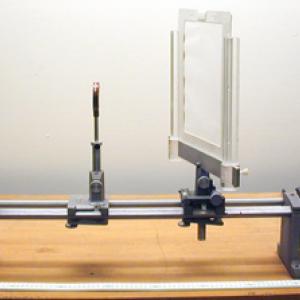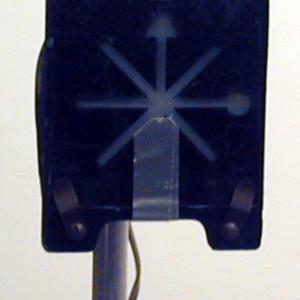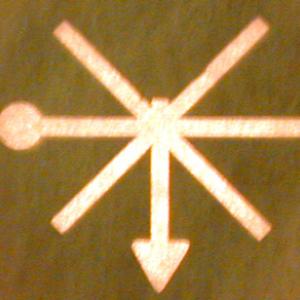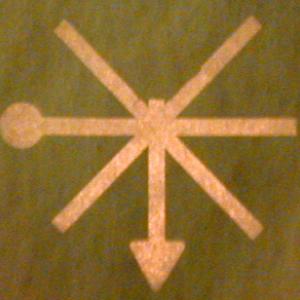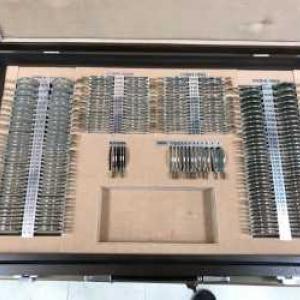College of Liberal Arts & Sciences
6A60.31 - Thin Lenses - Image Formation - Arrow Projector
Arrange the apparatus as shown. With the lenses you can project the inverted light image onto the screen which may be seen with the camera focused on the screen. You may also remove the screen and project the image directly into the camera thus simulating the human eye. The meter stick is for measuring focal lengths. To measure the focal lengths accurately you will need a distant parallel light source. Bring the light rays to a point with a lens on the paper screen. The distance from the paper screen to the lens is the focal length.
- Hakan Isik, "Using a Smartphone Camera's Manual Focusing in Distant Optics Lessons to Learn Lens and Mirror Images", TPT, Vol. 62, #6, Sept. 2024, p. 501.
- Sanjoy Kumar Pal, Soumen Sarkar, Surajit Chakrabarti, "Experimental Determination of the Transverse Width and Position of the Virtual Images Produced by Thin Lenses and a Plane Mirror with Smartphone Photography", TPT, Vol. 62, #5, May 2024, p. 367.
- Soumen Sarkar, Sanjoy Kumar Pal, Surajit Chakrabarti, "Determination of the Transverse Width and Distance of an Object with a Smartphone Camera", TPT, Vol. 61, #1, Jan. 2023, p. 58.
- Nada Razpet, Tomaz Kranjc, "Partially Covered Lenses and Additive Color Mixing", TPT, Vol. 55, #9, Dec. 2017, p. 537.
- James Kelly, "Displaying All Object-Image Pairs of an Optical System", TPT, Vol. 57, #5, May 2019, p. 293.
- Gordon R. Gore, "Another Way to Experiment with Images Formed by Lenses", TPT, Vol. 50, #5, May 2012, p. 314.
- Paul Gluck, "Teaching Image Formation by a Lens", TPT, Vol. 44, #4, Apr. 2006, p. 206.
- Samuel Hirschman, "Images From a Piece of a Lens [Phys. Teach. 7, 246 (April 1969)]", TPT, Vol. 42, #4, Apr. 2004, p. 251.
- Ronald Brown, "Thin-Lens Equation Nomograph", TPT, Vol. 42, #3, Mar. 2004, p. 156.
- "Correction: 'Longitudinal Magnification Drawing Mistake' [Phys. Teach. 42 (1), 31–33 (Jan. 2004)]", TPT, Vol. 42, #3, Mar. 2004, p. 133.
- Nector Rabal, Nelly Cap, and Marcelo Trivi, "Longitudinal Magnification Drawing Mistake", TPT, Vol. 42, #1, Jan. 2004, p. 31.
- Paul Hewitt, "Figuring Physics: Color Addition", TPT, Vol. 37, #2, Feb. 1999, p. 104.
- Se-yuen Mak, "Useful Comments on the May Issue", TPT, Vol. 36, #6, Sept. 1998, p. 325.
- A. M. Kwan and D. A. Wardle, "Covering Lenses and Covering Images", TPT, Vol. 36, #5, May 1998, p. 314.
- Dick Heckathorn, "Less Is the Same", TPT, Vol. 35 #3, Mar. 1997, p. 133.
- Eduardo C. Valadares and Luiz A. Cury, "An Image is Worth a Thousand Rays", TPT, Vol. 34, #7, Oct. 1996, p. 432.
- Pietro Ferraro, "Optics with Balloons", TPT, Vol. 34, #5, May 1996, p. 274.
- Dale W. Olson, "Real and Virtual Images Using a Classroom Hologram", TPT, Vol. 30, #4, Apr. 1992, p. 202.
- John W. Jewett, "Get The LED Out", TPT, Vol. 29, #8, Nov. 1991, p. 530.
- Jay S. Huebner, "Partially Blocking Converging Lenses", TPT, Vol. 27, #1, Jan. 1989, p. 43.
- Myron Effing, "An Extension", TPT, Vol. 16, #1, Jan. 1978, p. 8.
- Hugh F. Henry, "Object-Image Relations", TPT, Vol. 16, #1, Jan. 1978, p. 35.
- John S. Wallingford, "An Even Simpler Nomograph", TPT, Vol. 15, #7, Oct. 1977, p. 448.
- Myron Effing, "Representing Image Formation in Lenses and Mirrors", TPT, Vol. 15, #3, Mar. 1977, p. 178.
- Albert A. Bartlett, "Image Formation in Lenses and Mirrors, a Complete Representation", TPT, Vol. 14, #5, May 1976, p. 296.
- John J. White III, "Ray Diagrams for a Virtual Object", TPT, Vol. 10, #1, Jan. 1972, p. 33.
- Samuel Hirschman, "Images from a Piece of a Lens", TPT, Vol. 7, #4, Apr. 1969, p. 246.
- Hyman A. Cohen, "A Problem in Image Formation", TPT, Vol. 3, #7, Oct. 1965, p. 324, also A Potpourri of Physics Teaching Ideas - Optics and Waves, p. 212.
- M. C. Sullivan, "Using a Smartphone Camera to Explore Ray Optics Beyond the Thin Lens Equation", AJP, Vol. 90, #8, Aug. 2022, p. 610.
- Thomas B. Greenslade, Jr., Vacek Miglus, "Opticians Lens Set", AJP, Vol. 80, #10, Oct. 2012, p. 930.
- "O-300: Bulb Filament and Black Paper", DICK and RAE Physics Demo Notebook.
- "O-315: Right-Left Inversion", DICK and RAE Physics Demo Notebook.
- "O-320: Half Lens - Whole Image", DICK and RAE Physics Demo Notebook.
- Robert Ehrlich, "10.4, Partially Blocking a Converging Lens", Why Toast Lands Jelly-Side Down, p. 161.
- Martin C. Sagendorf, "The Double Convex Lens (and Others)", Physics Demonstration Apparatus, 2009, p. 43.
- Pat Murphy, Ellen Macaulay, and the staff of the Exploratorium, "Jell-O Lenses", Exploratopia, p. 298.
- David Kutliroff, "13, Make an Air Lens", 101 Classroom Demonstrations and Experiments For Teaching Physics, p. 38.
- David Kutliroff, "12, Images and Lenses", 101 Classroom Demonstrations and Experiments For Teaching Physics, p. 37.
- Borislaw Bilash II and David Maiullo, "A Real Lens", A Demo a Day: A Year of Physics Demonstrations, p. 345.
- Janice VanCleave, "Inverted", 200 Gooey, Slippery, Slimy, Weird, & Fun Experiments, p. 16.
- Sara Stein, "Forming Images", The Science Book, p. 188.
Disclaimer: These demonstrations are provided only for illustrative use by persons affiliated with The University of Iowa and only under the direction of a trained instructor or physicist. The University of Iowa is not responsible for demonstrations performed by those using their own equipment or who choose to use this reference material for their own purpose. The demonstrations included here are within the public domain and can be found in materials contained in libraries, bookstores, and through electronic sources. Performing all or any portion of any of these demonstrations, with or without revisions not depicted here entails inherent risks. These risks include, without limitation, bodily injury (and possibly death), including risks to health that may be temporary or permanent and that may exacerbate a pre-existing medical condition; and property loss or damage. Anyone performing any part of these demonstrations, even with revisions, knowingly and voluntarily assumes all risks associated with them.
